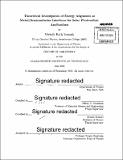Theoretical investigation of energy alignment at metal/semiconductor interfaces for solar photovoltaic applications
Author(s)
Tomasik, Michelle Ruth
DownloadFull printable version (21.59Mb)
Other Contributors
Massachusetts Institute of Technology. Department of Physics.
Advisor
Jeffrey C. Grossman and Senthil Todadri.
Terms of use
Metadata
Show full item recordAbstract
Our work was inspired by the need to improve the efficiency of new types of solar cells. We mainly focus on metal-semiconductor interfaces. In the CdSe study, we find that not all surface states serve to pin the Fermi energy. In our organic-metal work, we explore the complexity and challenges of modeling these systems. For example, we confirm that aromatic compounds indeed have stronger interactions with metal surfaces, but this may lead to the geometry changing as a result of the interaction. We also find that molecules that are not rigid are strongly affected by their neighboring molecules. Surface roughness will have an effect on molecules that more strongly bind to metal surfaces. This study of interfaces relates to one part of the picture of efficiency, but we also look at trying to go beyond the Shockley-Quiesser limit. We explore the idea of combining a direct and indirect bandgap in a single material but find that, in quasi-equilibrium, this does no better than just the direct gap material. This thesis hopes to extend our understanding of metal-semiconductor interface behavior and lead to improvements in photovoltaic efficiency in the future.
Description
Thesis: Ph. D., Massachusetts Institute of Technology, Department of Physics, 2015. Cataloged from PDF version of thesis. Includes bibliographical references (pages 115-124).
Date issued
2015Department
Massachusetts Institute of Technology. Department of PhysicsPublisher
Massachusetts Institute of Technology
Keywords
Physics.